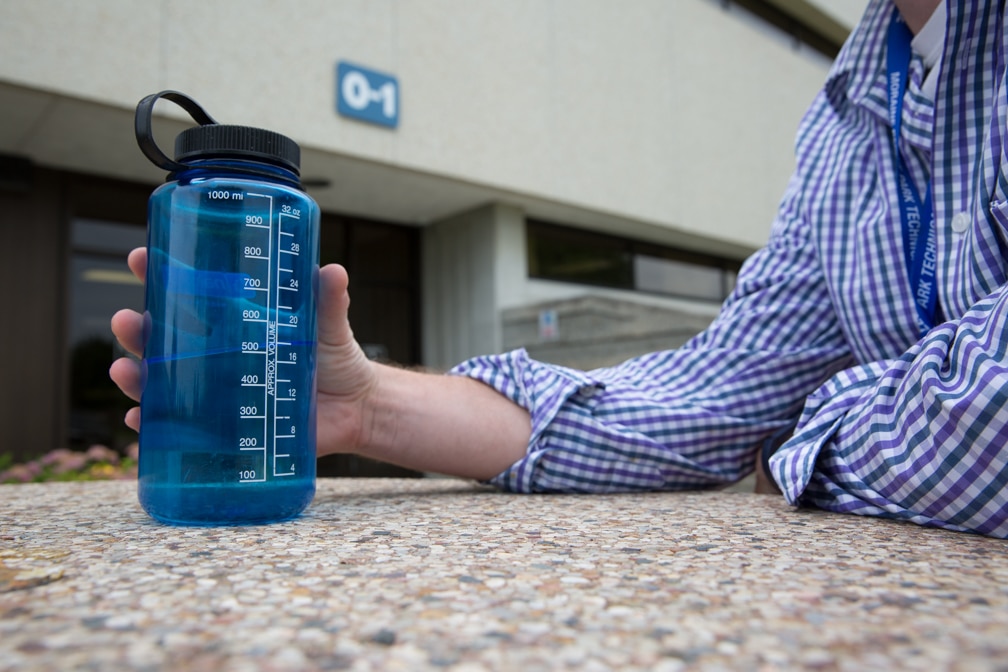Water on the go: What’s safe? What isn’t?

Summer is a time of high activity. Swimming. Fishing. Hiking. Biking. Running. The list goes on. And on! With high activity, accompanied often times with high temperatures, we all know the importance of staying hydrated. So always make sure you have enough water. There are times, however, when taking or carrying enough water is not practicable. For example, when we are hiking or backpacking for lengthy periods of time, the weight of water would make trekking across miles of terrain a very difficult journey. Considering each gallon would weigh in at 8.34 pounds, your backpack would be quite heavy.
But there are options available to meet our need of having enough water.
A story to share: As a Water Quality Technology Instructor here at Moraine Park Technical College, many friends ask me about drinking water. A common question is about drinking water from streams and lakes. Some go as far as to identify these streams and lakes as very clean. As a scout, I learned many skills, but one lesson I think I might have been the unknowing teacher. Let me share the story.
Looks can be deceiving
Long before I was interested in the water treatment career field, my scoutmaster was leading my troop in a backpacking trip when he came across a babbling brook. It certainly looked like something you would see in a travel brochure. A very beautiful site high in the pine-covered forest. He dipped down with his miner’s cup, and scooped up some water and drank up. Others joined him. I stopped, sat down and drank from my canteen. He exclaimed it was the purest and cleanest water on earth. He stated that water flowing over rocks was naturally purified. Oh, did it look refreshing!
I did wash my face with it and refreshed myself with the cool mountain water, but I opted not to drink. The scoutmaster noticed I did not drink and he asked why. I then explained that maybe the water was not as safe to drink as one may think. Certainly pollutants may not be an issue, but bacteria and microbes could very well be present. I used some graphic examples of how that may happen as wildlife also frequented the same stream. He then dumped his miner’s cup, and told everyone to drink from their canteens. I would later learn during water quality coursework, that a microbe called giardia causes an illness called giardiasis. Symptoms include severe diarrhea that can last several weeks. So when my friends ask me if it is OK to drink from a stream or lake, I tell them “Only if it is treated.”
Treated stream or lake water
Most any water that looks relatively clean and drinkable can be boiled for one to three minutes and kill bacteria, viruses, and protozoan cysts. It does take longer at higher altitudes, so always boil water long enough to provide safe water. Typically once at a rolling boil, your water should be safe to drink.
Boiling however does not remove lead or other contaminants that may be in the water. So if in an area of mining or past mining operations, you may want to consider another method. Regional water quality experts such as state water agencies may have good information to share regarding the area in which you will be trekking.
Water Purification
There are other options to boiling. Water purification tablets are also sold to hikers and backpackers. These will work against many bacteria, but not so well against cysts such as giardia and cryptosporidium. Tablets also have limited results in cloudy water and colored waters. Another option that I like is the all-inclusive filter. There are many available and all offer different levels of protection. So choose carefully.
Some will filter and treat the water using a flow through method such as pouring water through the device, maybe using pressure or pump, even a squeeze bottle, while others use a straw like device and your mouths suction to pull water through the filter providing you with clean, potable, drinking water. There are many competitors out there, but select the right one for your need. Look for pore size, micron removal size, removal efficiencies for varying organisms, but do your homework, making sure you are going to have a wonderful experience while enjoying the great outdoors this summer and many more.
Drink up!
And for more information about water quality and education available, visit our Moraine Park Technical College Water Quality program page.


